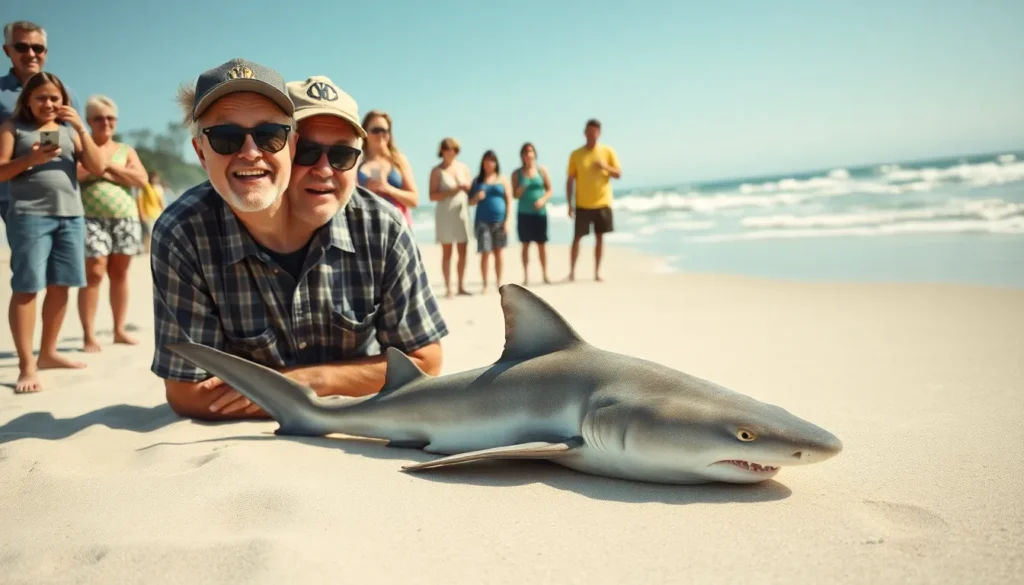Table of Contents
ToggleImagine stepping outside for a breath of fresh air and suddenly finding a baby hammerhead shark plummeting from the sky. Sounds like a scene straight out of a quirky movie, right? But this bizarre phenomenon actually happened, leaving onlookers both bewildered and amused.
As if nature decided to throw a curveball, this unexpected drop raises questions about how a baby shark ended up in a place where it clearly doesn’t belong. Was it a case of mistaken identity or perhaps a new method of ocean delivery? Dive into this whimsical tale that combines marine biology with a sprinkle of humor, and discover the wild world of unexpected sky divers. Who knew that the ocean’s cutest predator could make such a splash on land?
Overview of the Phenomenon
A baby hammerhead shark falling from the sky presents a rare ecological event. This occurrence likely stems from waterspouts or strong storms, which can lift marine life from the ocean. Witnesses express disbelief and intrigue, noting the shark’s small size and unusual landing.
In various documented incidents, similar events involve fish or small animals descending after severe weather conditions. The phenomenon, although bizarre, isn’t entirely unprecedented. Instances of fish raining down date back to ancient times, with some reports claiming this happens due to tornadoes or waterspouts.
Observers highlight the shark’s condition upon landing. Typically, marine animals experience stress or damage when lifted from their habitats. Understanding the environmental implications remains crucial, as it showcases the changing dynamics of weather patterns.
Research into this phenomenon reveals that hammerhead sharks, known for their distinctive heads and social behavior, inhabit warm ocean waters, primarily in tropical and subtropical regions. Rescuing and rehabilitating the fallen shark poses challenges, including determining the best course of action for its health. It’s essential to coordinate with marine biologists and wildlife rescue organizations to ensure its survival.
While the whimsical nature of this incident captivates the public’s imagination, it also raises awareness of our planet’s delicate ecosystems and the influence of weather anomalies. People increasingly recognize the need for scientific exploration of such occurrences to understand their frequency and impact on marine life.
Eyewitness Accounts

Witnesses provide intriguing accounts of the baby hammerhead shark’s unexpected fall. Their stories reveal surprise and amusement at witnessing such a rare event.
Individual Stories
One local resident described feeling astonished as the shark landed mere feet away. Another bystander noted the tiny creature flopping around, prompting them to hurry over for a closer look. A marine enthusiast mentioned taking video footage to share online, capturing the peculiar moment. Many found themselves laughing at the sight; it seemed unreal to witness a live shark in such an unusual setting. These individual accounts highlight the joy and confusion that the incident sparked in the community.
Patterns and Locations
Reports indicate that unusual meteorological events often precede occurrences like this. Documented cases show that waterspouts frequently lift marine life from the ocean, leading to falls inland. Locations experiencing similar bizarre phenomena include coastal towns with a history of fish or small sea creatures raining down. Witnesses noted that areas prone to storms or strong winds had reported comparable incidents before. Understanding these patterns aids in grasping the broader implications of such extraordinary happenings in nature.
Scientific Explanations
Understanding the scientific reasons behind a baby hammerhead shark falling from the sky involves examining meteorological factors and oceanic connections.
Meteorological Factors
Strong storms can create waterspouts that lift marine animals from the ocean. Waterspouts form when warm, moist air rises rapidly, twisting into a vortex. Winds associated with severe weather lead to strange phenomena, including the rain of fish or small sharks. This dynamic results in unexpected drops of marine life in unexpected locations, surprising onlookers. The unique atmospheric conditions in coastal regions contribute to these peculiar incidents, often prompting community curiosity. Experiences with other similar events highlight the impact of weather systems on marine ecosystems.
Oceanic Connections
Ocean currents shift marine life significantly, enabling mobility under specific conditions. When fighting strong winds or storms, small sharks may become disoriented. Hammerhead sharks, particularly younger ones, often travel in shallow waters. Such habitats can easily intertwine with adverse weather, increasing the likelihood of accidental displacements. Feeding patterns also influence movement, leading to situations where sharks find themselves in unfamiliar territories. While these connections are complex, they offer insight into how oceanic changes relate to unusual meteorological events, affecting marine life ecosystems.
Implications for Wildlife
The unusual incident of a baby hammerhead shark falling from the sky highlights various implications for wildlife. Events like this prompt a closer look at how environmental factors affect marine populations.
Impact on Hammerhead Shark Populations
Hammerhead shark populations may face increased vulnerability due to displacement from their habitats. Young hammerheads are particularly sensitive to environmental disturbances like storms and strong currents. When these sharks are lifted by waterspouts, survival rates diminish significantly. Disoriented individuals struggle to navigate back to familiar waters. Continuous disruptions could lead to population declines if events become more frequent. Conservation efforts must address these challenges while studying their long-term impact on juvenile hammerhead survival.
Ecosystem Considerations
Ecosystem balance hinges on the stability of marine life. The unexpected presence of a baby hammerhead shark disrupts local food webs. Predators may capitalize on such events, leading to shifts in predator-prey dynamics. Nutrient cycling can also be affected when marine organisms are relocated. These shifts can alter habitat health, impacting both marine flora and fauna. Monitoring such occurrences becomes essential for preserving marine diversity and informing conservation strategies.
The unexpected drop of a baby hammerhead shark highlights the fascinating and often unpredictable nature of our environment. This whimsical incident serves as a reminder of the intricate connections between weather phenomena and marine life.
As communities reflect on such rare occurrences, it becomes essential to consider the broader implications for wildlife and ecosystems. Understanding the factors that lead to these events can aid in developing strategies to protect vulnerable species.
With continued research and awareness, society can better appreciate the delicate balance of marine ecosystems and the challenges they face. This baby hammerhead shark’s journey from ocean to sky underscores the need for ongoing exploration and conservation efforts to ensure the health of our oceans.




